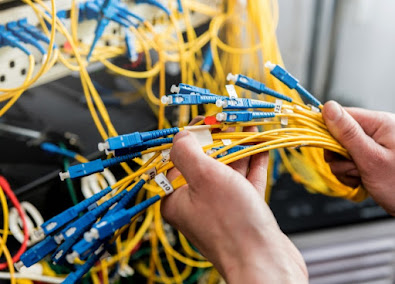- Get link
- X
- Other Apps
Posted by
W.K. Malith Rajaka
- Get link
- X
- Other Apps
Network Traffic/Data Traffic
It describe amount of data or Data packets transfer through a network at a given point of time. Network traffic is the main component for network traffic measurement, network traffic control and simulation.
- Network traffic control:- Managing, prioritizing, controlling or reducing the network traffic
- Network traffic measurement:- Measuring the amount and type of traffic on a particular network
- Network traffic simulation:- To measure the efficiency of a communications network
- Traffic generation model: - It is a stochastic model of the traffic flows or data sources in a communication computer network.
By analyzing data traffic you can identify security threats for the company. E.g.:- unusual data traffic can be occurred due to a malware or any other attack.
Network Cables
Networking cable are hardware used to connect networking devices together. Type of the cable depend on network’s physical layer, topology and network size. Also there are IEEE standards for cabling and they help to maintain reliability and speed of the network.
Coaxial Cables
This type of cable have an inner copper conductor covered with tubular insulating layer and tubular conducting shield. Many coaxial cables also have an insulating outer sheath or jacket. Middle conductor carry electrical signals while the Shield is there for ground potential. There are two types of coaxial cables such as Thicknet (10BASE5) and Thinnet (10BASE2).
ThickNet:- This type of coaxial cable able to span distances of up to 500 meters. Popular in applying for backbone of LANs (BUS topology). Systems connected to the cable using an external transceiver unit than actually tapped directly into the wire. The transceiver connected to a network card using an Attachment Unit Interface cable.
ThinNet:- It can extend of up to 185 meters. This was usually the media of choice for connecting computers on a LAN. Systems connect to the network via a BNC-T connector attached to the network card.
Twisted Pair Cables
These type of cables are made by intertwining two separate insulated wires. There are two twisted pair types as Shielded Twisted Pair and Unshielded Twisted Pair. UTP is common in Ethernet installations (for normal installations), common in computer networking.
In Shielded Twisted pair cables each pair of wires are wrapped in a metallic foil. The four pairs of wires then are wrapped in an overall metallic braid or foil, usually 150-ohm cable. STP is used to prevent crosstalk and electromagnetic interference. STP provide grounding and also it ensures maximum bandwidth can be get. Twisted pair cables are low in cost than fiber optic cables and also the installation is much easy.
Commonly used types of UTP cabling are as follows:
- Category 1:- Used for telephone communications. Not suitable for transmitting data.
- Category 2:- Capable of transmitting data at speeds up to 4 Mbps.
- Category 3:- Used in 10BASE-T networks. Transmit data at speeds up to 10 Mbps.
- Category 4:-Used in Token Ring networks. Transmit data at speeds up to 16 Mbps.
- Category 5:- Transmit data at speeds up to 100 Mbps.
- Category 5e:- Used in networks running at speeds up to 1000 Mbps.
- Category 6:- Typically, Category 6 cable consists of four pairs of 24 American Wire Gauge (AWG) copper wires. Category 6 cable is currently the fastest standard for UTP.
Fiber Optic Cables
It is a network medium capable of conducting modulated light transmission. Fiber optic cable consists of two fibers wrapped in separate coverings. As you can see in the above picture, each optical fiber surrounded with protective buffer material (a plastic shield). Then with a Kevlar reinforcing material and with an outer jacket.
The plastic conforms to appropriate fire and building codes. Kevlar is there to provide additional cushioning and protection. Where buried fiber-optic cables are required, a stainless steel wire is sometimes included for added strength. SC is the most common Fiber optic connector. It has two optics one is there to connect for transmit and other one is there to connect with receive.
The light-guiding parts of an optical fiber are called the “Core” and the “Cladding”. Core contains with pure glass with high index of refraction. Cladding layer (glass or plastic with low index of refraction) surround the Core and the light trapped inside the fiber core. This process is known as Total Internal Reflection. Due to this process optical fiber acts as a light pipe which guide the light for long distances and also around bends. This is the most expensive network cable type, but it is the fastest data transmitting cable type. As they are transmitting light (no electrical signals) other devices can’t get those signals, so fiber optics are much secure. There are two types of fiber optic cable types as Single mode and Multi-mode.
- Single mode:- this cable only allows to broadcast one mode or wavelength of light. This type of cable has higher bandwidth and capable send signals for more distance than multimode. This cable type use lasers as light generating method and also more expensive than multimode cables. Maximum cable length is about 60+km.
- Multimode: - this cable allows to broadcast multiple modes of light. It use LEDs as light generating method. The maximum length is about 2km.
- Get link
- X
- Other Apps





